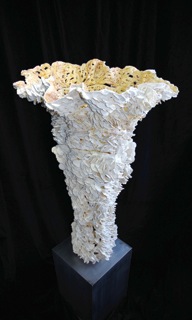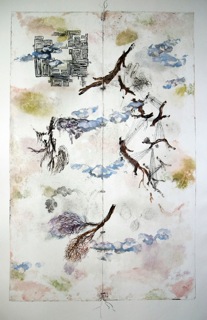2011-01-11
Adina Balint
Susan Collett: Toronto Visual Artist
Susan Collett lives and works in Toronto. A talented ceramist, she models white earthenware paper clay, produces etchings and installations and, between 2004-2007, she created a collection of copper rugs, entitled The Flying Carpet Series. All through her projects, the artist finds original ways of reflecting upon the limits of reality and fantasy, upon “life in motion”, “light and shadow”, “desire and beauty”. She leaves marks of singularity in major galleries and museums around the world: The Museum of Porcelain of Sevres (2010), Burlington Art Centre, Canada and Ceramic Artists Association of Israel (2009), Sofa Chicago (2008), to name only these contributions.
 |
 |
||
Labyrinth Series: Hive Trumpet: 107cm H x 58 cm W x 69 cm D |
Lineage Vl 38"H x 24"W |
Works by visual artist Susan Collett boldly express the porous borders of the visible and the invisible. Her materials melt in imaginary contours, heartbreaking and torn, and the transgression turns out to be a harmonious adventure. There is symmetry, a fine attention to detail, a grace of observing ordinary things that lead us to say that the Canadian artist models beauty more than any other violent, obscure or ugly aesthetic category. Collett's work vibrates: her art does not take us away from reality, but gives us the opportunity of a fresh perspective on the real, original and deep.
Having discovered her name at the Toronto International Art Fair (TIAF), I followed Collett’s work in various arts publications (International Ceramic Review, Contemporary Ceramics), browsed her website: www.susancollett.ca and paid an exciting visit to her studio in a bohemian neighbourhood of Toronto. I still remember that day in the artist’s studio like one when I came to understand that there are rituals and movements of the hand and of the mind that make life meaningful. A visit to an artist's studio is certainly a proof that art is living, changing and growing. Spending a moment with Susan Collett meant sharing kindness and grace while a sense of complicity between the artist’s personality and her universe came along naturally. Her presence spread magic over the workplace and gave it an aura of sacred. Suddenly the studio seemed more than just physical space; it was the medium of creation, the metaphor of incarnated desire and an archaic call come into shape.
Collett recognizes that her projects attempt to “give meaning to existence” (Espace Sculpture Magazine, No. 79, Spring 2007). By her artist statement, she explains how the disciplines of printmaking and clay sculpture are complementary in her artistry: “Working with clay influences my printmaking, encouraging an unorthodox approach of tearing, perforation and drawing back into the prints. The monoprints incorporate drypoint onto plates composed of industrial copper sheeting that I stitch and reconstruct, allowing for unlimited large-scale imagery. Like the tabbing in the ceramic Labyrinth series, I reaffirm perceptions of fragility and transience”. (On line: http://www.susancollett.ca/bio/statement/index.html). Throughout her productions, Collett seeks to express connections between opposing forces: the liquid and the solid, water and earth, states of matter, elements of nature, the ancient and the modern. For the attentive viewer, this vision is also revealed in the choice of materials: sometimes soft, sometimes strong, clay or copper.
Furthermore, the titles and topics of the installations appear as a nod to history: Impluvium (the title is a Latin term which means a large pool located on the floor of the atrium of the Roman house designed to collecting water) is a project that works the confluence of water, air and matter; Labyrinth reminds us of the myth of Daedalus and the Flying Carpet Series roundabout way back to Oriental mythology and the imagination of the One Thousand and One Nights. Beside artwork, through history and writing – Collett lists thumbnails and collects photos and notes of work, stating stories of interior design projects – we discover the multi-facetted world of the artist. A lively universe open to different mediums of creation: sculpture, printmaking, interior design, text and texture.
Susan Collett's work with light and movement deserves attention. On the one hand, spiral and undulating forms suggest the tension between stability and the ability to turn around an axis; fixity and mobility, the point and the spiral. These forms like trumpets or huge flower vases open up to the sky; they long for light and thus aspire to the sacred. Is there transcendence?, they seem to inquire. On the other hand, light and shadow better reveal perforation. The beams of sun pierce paper clay; they transgress the smooth surface of the art pieces in order to project it into new horizons and new interpretations. After all, it is known that art captures fascinating encounters with the other and the unexpected, with hope and promises.
In the space of a gallery, in the open air or in her studio, Susan Collett’s artwork conveys a powerful message about our human impossibility of retaining light, water and air. Her projects finely raise a question about the slippery nature of the universe. With her, it becomes natural that boundaries delineating environments and materials are transient. Transgression is to be inherent. And we do enjoy discovering an artist who sensitively explores life's layers, while in the process we come to acknowledge that our obsession to retain too much is eternally doomed to failure. However, this sometimes painful, demanding, threatening to collapse work in progress is also salutary: it well implies hoping and looking beyond the ritual of a recurrent absurd Sisyphus.